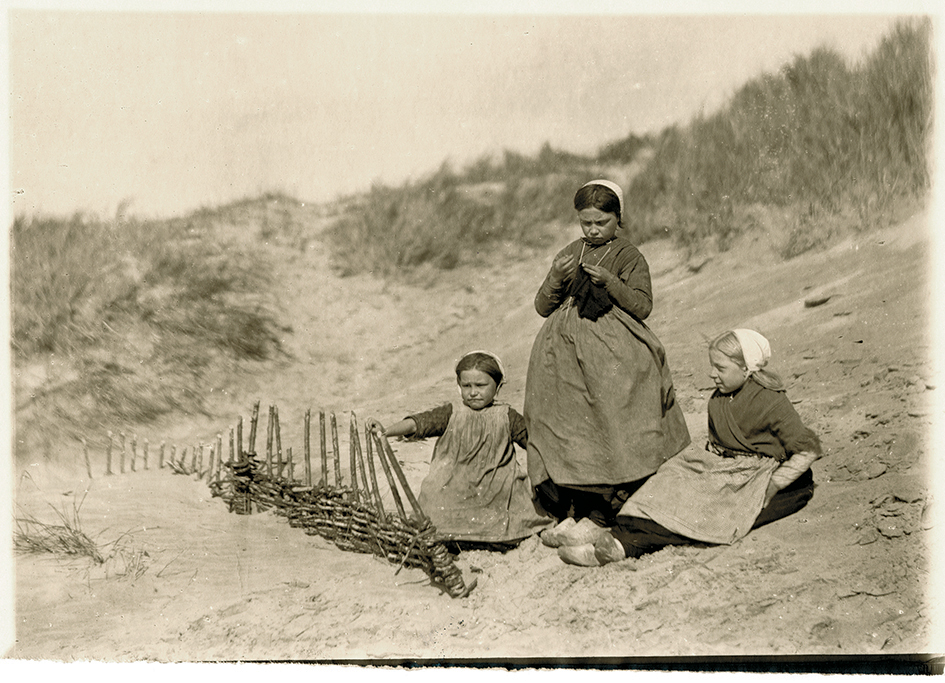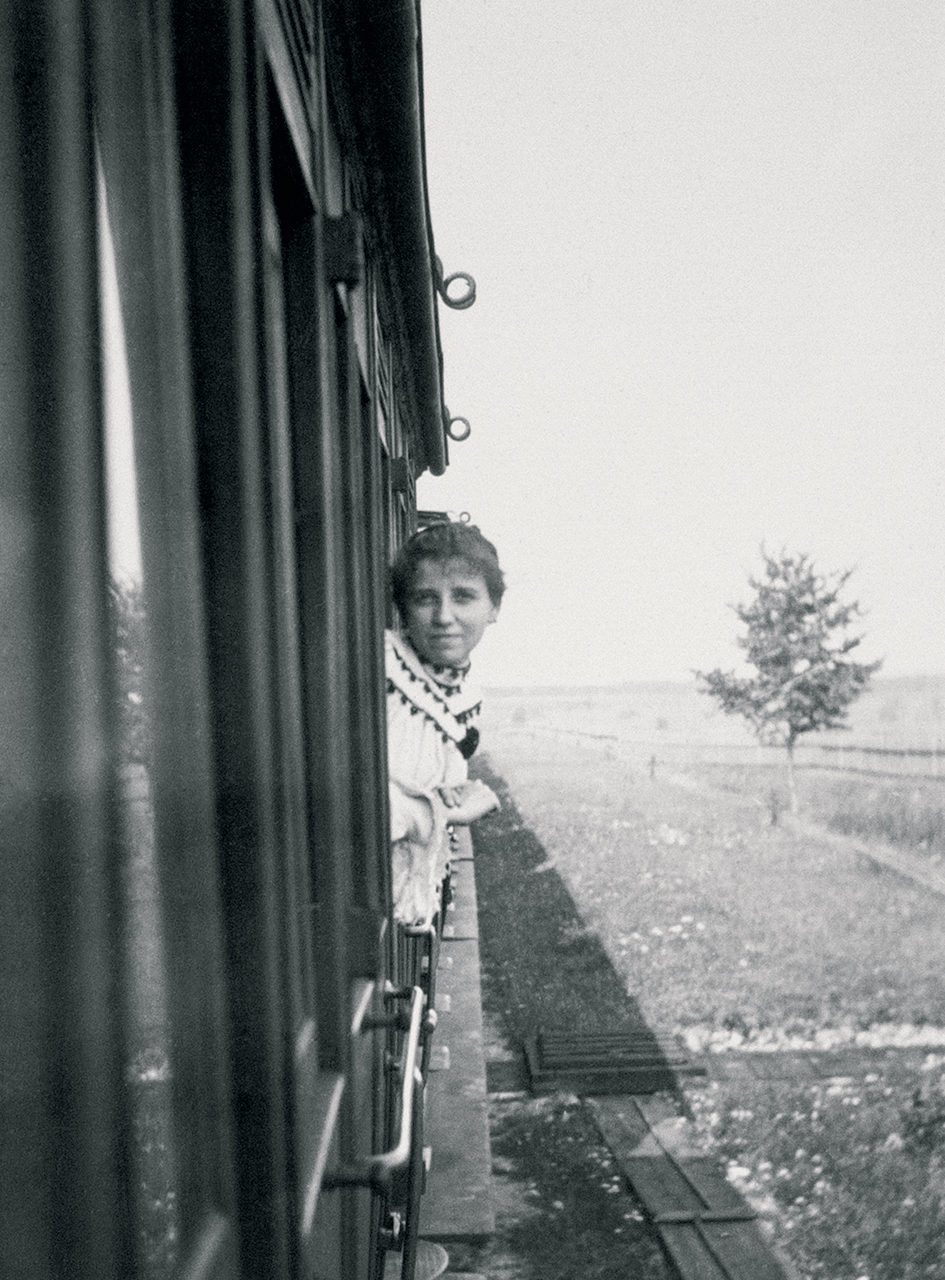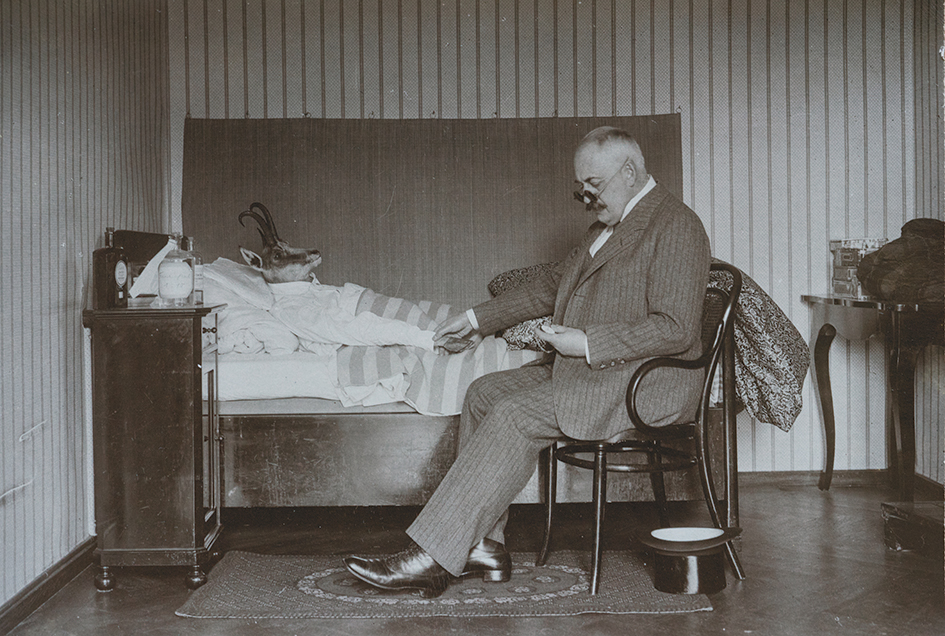Photographs by Camera Clickers and Serious Amateurs
At the start of June 1901, Count Karel Chotek ordered his servants to pack
for a trip for him and his entire family. He and his wife, Adelaide, had been
planning an excursion to Holland for quite a while – the Count had already
previously visited Noordwijk aan Zee during his European travels. This time,
however, he told his servants to also pack his photography equipment.
Although the Count’s interest in photography started in 1885, he gradually
progressed from being just a “camera clicker” (following from the German
designation of “knipster”, meaning one who just presses the shutter release
without any great deliberation), to becoming a “serious photographer” (the
designation photo club members used to show that they had a deeper
interest in photography).1 The Dutch seaside resort previously mentioned was
a popular destination for artistic photographers at that time – for instance,
both Alfred Stieglitz and Heinrich Kühn, who were amongst the leaders of the
contemporary amateur photography movement, took pictures there.
Chotek gradually mapped out a number of his trips abroad, mainly
those that were family holidays. In this way, he was actually the forerunner
of a phenomenon that did not spread throughout mainstream society until
decades later. However, to fully understand the situation, we must go a bit
further back in history, to approximately 1870. Although, at that time, forty
years had already passed since the introduction of the daguerreotype,
ownership of a camera was not at all common. Back then, photography
equipment was owned only by professional photographers, who needed
it to earn a living, scientists who used this innovative way to record their
discoveries, and enthusiasts, who had sufficient time and money for this
unusual hobby. The latter came, for the most part, from the aristocracy.
As far as the economic perspective is concerned, it is quite clear who
was able to acquire photography equipment during the period from about
the second half of the 19th century to around the 1920s. In Austria (and
thus also in the Czech lands), prior to 1900 a camera could be obtained
for an amount ranging from 130 to 280 Austro-Hungarian gulden. Of
course, the cost of various accessories, such as photographic paper, had
to be added to that. According to available advertisements from that time,
some manufacturers charged four gulden for a packet containing twentyfive
sheets. It needs to be kept in mind, that around the start of the 1890s
a qualified labourer earned approximately only thirty-five kreutzer for ten hours
of hard work, which comes out to two gulden per week. After 1892, when the
gulden was replaced by the crown at an exchange ratio of 1 to 2, labourers
could start earning more. Additional growth in income followed, mainly after
1906. Nevertheless, even then the majority of labourers took home weekly
wages ranging from eleven to seventeen crowns, which was barely enough
to cover the living expenses of a family of four.2 Even so, the situation did
gradually change. Inexpensive cameras for amateurs started to be sold in
North America as early as the end of the 19th century. This revolution was
begun primarily by the Kodak Company with its Brownie camera, which could
be obtained for the price of one dollar. For that matter, Kodak had already
captured attention several years earlier with its advertising slogan aimed at
the general public: “You press the button, we do the rest.” Although Europe
was several years behind in this respect, photography slowly started to
become a mass phenomenon on this continent as well.
The key condition that allowed people to devote themselves to
photography as a hobby was a sufficient amount of free time. As late as
the second half of the 19th century, it was specifically the aristocracy who
belonged to the privileged group of individuals who did not have to spend most
of their day earning a living. There were a number of hobbies that aristocrats
used to fill their leisure time in those days, including hunting, horseback riding,
and fencing. Gradually, new activities were added to the list, such as sports
(chiefly the very fashionable game of tennis), flying, and motoring. In the case of
the last, it is possible to cite the historians Miloš Hořejš and Jiřího Křížek, who,
in their book Zámek s vůní benzínu (A Petrol-Scented Mansion) write: “At first,
the general public viewed the automobile as a luxury item for the entertainment
and amusement of the uppermost classes. (…) However, in a way we owe
much to this eccentricity of the uppermost classes, as, thanks to the example
they set, the automobile set out on its long journey leading into the hearts of
the overall population”.3 This quote may be applied to other things as well.
The conditions for spending one’s leisure time changed only very slowly
for mainstream society. In the lands falling under the Austrian crown, leisure
time was officially defined in March 1885,4 when independent tradesmen
were forbidden to work on Sundays. The average length of working hours
was gradually changing as well. During the first half of the 19th century, it
was between twelve and fourteen hours a day. It gradually decreased to eight
hours a day, but this did not apply to all workers.
The time designated for relaxation also underwent changes. For
example, in 1884 new rules for holiday leave were defined for government
clerks and soldiers. All in all, around 1890 these gradual societal changes
started to provably raise interest in photography amongst a larger group
of individuals from the ranks of not only affluent industrialists and military instance,officers but also higher-placed state officials. This may be seen in, for
instance, the membership lists of various amateur photography clubs.
At first, the change in the way in which leisure time was perceived
affected chiefly men. Whilst women from the untitled classes had a fixed
daily schedule that did not offer them any free time, men had the luxury of
being able to relax after work.
Based on the above information, it is clear who had the best opportunity to
enjoy photography as a hobby. In the case of Karel Chotek, the photographs he
took during his trips to Holland, Italy, and various locations in Austria-Hungary
have been preserved. His wife, Adelaide, almost always travelled with him. She
had her own camera and also took pictures during their trips. The themes each
of them captured were, however, very similar and corresponded to the main
canon of that time – searching for an ideal, unblemished landscape. Particularly
in the case of Karel Chotek one finds idealised images of common people and
their hard work, as well as romantic views of the sea and mountains.
There were dozens of other noblemen in the Czech lands who used
photography to document their journeys . The book Fotografové šlechtici
v zemích Koruny české (Aristocratic Photographers in the Lands of the
Bohemian Crown)5 was published in 2017, and it charts the photographic
works of forty of them. For several years the list of active photographers
included František Thun-Hohenstein. In comparison to other aristocrats, he
started photographing quite a bit later, some time around 1898, when he
was about fifty, no longer active in high politics, and after his daughter, Anna,
was born. The Thun-Hohenstein family archives include several extensive
albums capturing his journey to, for example, Davos, various Italian resorts, and
a number of excursions throughout the Czech lands.
Other aristocrats travelled even further – to places such as North America
or the Middle East. Particularly expeditions to Egypt, Sudan, and Somalia were
popular. In the first years of the 20th century, trains operated by the Ugandan
railways, leading from the port in Mombasa to the shores of Lake Victoria,
started to bring dozens of enthusiastic hunters to eastern Africa. They included
Adolf Schwarzenberg and his wife, Hilda. An abundant quantity of photographic
materials from this journey have been preserved, and it appears that both of the
aristocrats were involved in taking a number of the pictures.6 Other noblemen
who set out on hunting expeditions to various African countries were Johann
Nepomuk Pálffy and Josef Colloredo-Mansfeld. Some of the latter’s African
photos may be found in ethnographic studies of the inhabitants.
What has been outlined above describes – to quite a significant extent
– how we handle a camera. The themes captured in photos taken a hundred
or more years ago are not all that different from those found today. When you
browse through your own albums, you will find pictures that are mostly of
a personal nature, helping to preserve memories. Basically the only thing that has
changed is the share of the population that takes photographs. While just a short
hundred years ago, photography was a hobby enjoyed only by a very few, today
everyone has the ability to take pictures with their mobile. On the other hand,
the proportion of camera clickers compared to serious photographers will be
different, with the former undoubtedly outnumbering the latter.
Jan Vaca
1 TRNKOVÁ, Petra. Technický obraz na malířských štaflích: Česko-němečtí fotoamatéři
a umělecká fotografie, 1890–1914 (The Technical Image on a Painter’s Easel: Artphotography and Czech-German Photo Amateurs, 1890–1914). Brno: Barrister &
Principal, 2008, p. 19.
2 “Sociální úroveň dělnictva na počátku 20. století” (“The Social Level of the Labour Force at the Start of the Twentieth Century”). E-dejiny.cz. (online). 1 December 2008. Accessible at: http://www.edejiny.cz/socialni-uroven-delnictva-na-poc20stol/ (in Czech only).
3 HOŘEJŠ, Miloš and KŘÍŽEK, Jiří. Zámek s vůní benzínu: Automobily a šlechta v českých zemích do roku 1945 (A Petrol-Scented Mansion). Prague: Mladá Fronta, 2015, p. 9.
4 TRNKOVÁ, Petra. Technický obraz na malířských štaflích: Česko-němečtí fotoamatéři
a umělecká fotografie, 1890–1914 (The Technical Image on a Painter’s Easel: Artphotography and Czech-German Photo Amateurs, 1890–1914). Brno: Barrister &
Principal, 2008, p. 21.
5 VACA, Jan et al. Fotografové šlechtici v zemích Koruny české (Photographer Aristocrats in the Czech Crown Lands). Prague: National Heritage Institute, 2017. Svědectví fotografie, sv. 2. (Testimony in Photographs, Vol. 2)
6 SLABOVÁ, Markéta and SLABA, Martin. Poslední ráj Adolfa Schwarzenberga (Adolf
Schwarzenberg’s Last Paradise). Prague: National Museum of Agriculture, 2014, p. 77.





#32 non-work
Archive
- #45 hypertension
- #44 empathy
- #43 collecting
- #42 food
- #41 postdigital photography
- #40 earthlings
- #39 delight, pain
- #38 death, when you think about it
- #37 uneven ground
- #36 new utopias
- #35 living with humans
- #34 archaeology of euphoria
- #33 investigation
- #32 Non-work
- #31 Body
- #30 Eye In The Sky
- #29 Contemplation
- #28 Cultura / Natura
- #27 Cars
- #26 Documentary Strategies
- #25 Popular Music
- #24 Seeing Is Believing
- #23 Artificial Worlds
- #22 Image and Text
- #21 On Photography
- #20 Public Art
- #19 Film
- #18 80'
- #17 Amateur Photography
- #16 Photography and Painting
- #15 Prague
- #14 Commerce
- #13 Family
- #12 Reconstruction
- #11 Performance
- #10 Eroticon
- #9 Architecture
- #8 Landscape
- #7 New Staged Photography
- #6 The Recycle Image
- #5 Borders Of Documentary
- #4 Intimacy
- #3 Transforming Of Symbol
- #2 Collective Authorship
- #1 Face
